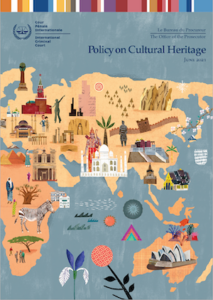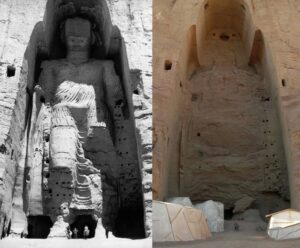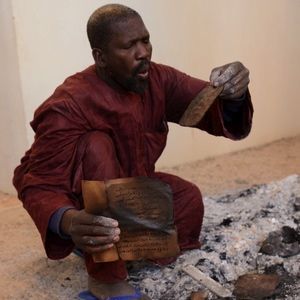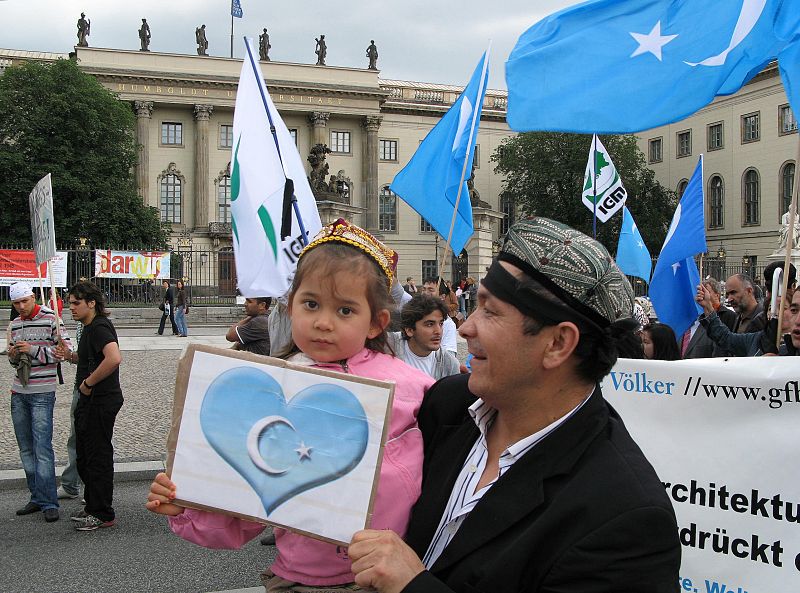New ICC Policy on Cultural Heritage

Cover of the ICC’s Policy on Cultural Heritage issued June 2021.
A new Policy on Cultural Heritage[1] was issued in June 2021 by Mrs. Fatou Bensouda, the Prosecutor of the International Criminal Court. In a recent announcement,[2] Mrs. Bensouda clarified that willful attacks on cultural heritage are a criminal violation of the Rome Statute,[3] the treaty that created the International Criminal Court. The Rome Statute was adopted by the United Nations Diplomatic Conference of Plenipotentiaries on the Establishment of an International Criminal Court in 1998 and came into force on July 1, 2002.
The ICC is an international court having jurisdiction over four major forms of crimes: genocide, crimes against humanity, war crimes, and the crime of aggression (the use of armed force against another state). It is a court of last resort, either if a State is a signatory to the Rome Statute, or if a State accepts the ICC’s jurisdiction.
The ICC has the power to exercise its jurisdiction over persons for the most serious crimes of international concern – genocide, crimes against humanity, war crimes, and aggression against another state. Prosecutions by the ICC are not limited to cultural destruction while in an actual state of war. They may result from actions during and after the immediate conduct of hostilities. The destructive acts may be against a civilian population instead of combatants.
Regardless, the ICC is limited in jurisdiction to acts occurring on the territories of signatory states. If a State is not a signatory and is unwilling to be subject to the ICC’s jurisdiction, these are intractable barriers to its reach. Most importantly, like almost all other international bodies, the ICC is state-centric. When a nation state chooses to act against its own population, religious institutions, and monuments, even perpetrating the most serious crimes against humanity against its own people, international organizations (including the ICC and UN agencies such as UNESCO) are for the most part unable or unwilling to act.

The larger Bamiyan Buddha, before and after it was blown up by Pakistani Taliban in 2001.
As Thomas G. Weiss and Nina Connelly stated in their paper “Cultural Cleansing and Mass Atrocities: Protecting Cultural Heritage in Armed Conflict Zones”:
“For example, the destruction of the Bamiyan Buddhas may not have constituted a loss of cultural heritage according to the 1970 [UNESCO] convention, because the Taliban government representing the Afghan state did not view them as such. In addition, the protection of the cultural heritage of minority groups—of Rohinga and Uyghur mosques in Myanmar and China’s Xinjiang province, or churches and synagogues in Syria, or Yazidi shrines anywhere—depends on the designation by and request from a government that may or may not value them and in many cases is committed to destroying them.”[4]
Because of its limited jurisdiction, the ICC’s statements in its Policy on Cultural Heritage may not at first appear relevant to the current situation in Xinjiang, China, where Chinese government officials are carrying out an official policy to erase the culture of the Uyghur, a living people who are their own citizens. The enactment of this policy has included mass incarceration of over a million Uyghurs, forced labor, the systemic use of rape and forced sterilization, the separation of hundreds of thousands of children from their parents,[5] and other acts showing intent to commit genocide.
(For more information on the ongoing acts of violence against the Uyghurs and Eastern Turkistan’s cultural traditions, please read Dr. Magnus Fiskesjö’s Bulldozing Culture: China’s Systematic Destruction of Uyghur Heritage Reveals Genocidal Intent, Cultural Property News, June 23, 2021)
How the ICC’s new Policy on Cultural Heritage ties destruction of cultural heritage to genocide

Demonstration for Uyghur rights, Berlin, 19 January 2020, Photo by Leonhard Lenz, CC0 Universal Public Domain Dedication.
The ways in which the intent to destroy cultural heritage is intertwined with the crime of genocide and other crimes against humanity are stated in many ways throughout the ICC’s Policy on Cultural Heritage. It states: “Genocide… may be effected by killing members of the group, causing serious bodily or mental harm to members of the group, deliberately inflicting on the group conditions of life calculated to bring about its physical destruction in whole or in part, imposing measures intended to prevent births within the group, and forcibly transferring children of the group to another group…”
Here are some important excerpts from pages 30-32:
“i. Specific intent
“[Paragraph] 79. Crimes against cultural heritage occurring simultaneously with other acts targeting protected groups may provide evidence of the specific intent (dolus specialis) required for genocide. While attacks on cultural heritage do not per se constitute underlying acts of genocide — because acts of genocide are limited to those seeking the physical or biological destruction of a group — the targeting of a group’s cultural heritage may constitute evidence of the perpetrator’s intent to destroy that group. The International Court of Justice (“ICJ”) has stated that: Where there is physical or biological destruction there are often simultaneous attacks on the cultural and religious property and symbols of the targeted group as well, attacks which may legitimately be considered as evidence of intent to physically destroy the group.”
See also:
“iii. Inflicting conditions of life calculated to bring about the group’s physical destruction: article 6(c)
“[Paragraph] 84. The IACtHR has also recognised that [events impairing the physical existence of a group, and also targeting its collective integrity and identity, also lead to] “the violation of cultural rights, the repression of the culture and the symbols of identity, the prohibition to perform religious rites or ceremonies, impeded the reproduction of social relations, the formation of family relationships, the facilitation of financial practices, and fragmented the sense of belonging to a group”. In these ways, acts imposing conditions of life calculated to bring about a group’s physical destruction that also target or affect cultural heritage as part of a genocidal campaign inflict ruinous conditions of life on a group.”
Past trials involving cultural heritage at the ICC

Screenshot from CNN video ‘Pure evil’: Satellite images show destroyed Uyghur graves in China,” report by CNN’s Matt Rivers, https://www.youtube.com/watch?v=gUSQm1ubstA
It may be useful to see how the ICC has defined cultural destruction as a crime in the past and developed policies that recognize cultural destruction as a form of genocide. Even if the ICC is powerless in this case, it can assist other international bodies to understand that cultural heritage has essentially a human value, not a purely national one, as is too often claimed. As James Cuno, longtime President of the J. Paul Getty Trust, has said – “cultural heritage” is “movable and immovable artifacts and immovable structures of historical and cultural significance to humanity.”[6]
Investigations of cultural destruction, occasionally followed by prosecutions, have been undertaken by the ICC in the past.

Trying to rescue burned manuscripts in Timbuktu after Ansar Eddine attack.
Cultural crimes have come before the court in cases of destruction of cultural heritage in Mali. Prior prosecutions involved charges against Ahmad Al Faqi Al Mahdi, who was found guilty as a co-perpetrator of the war crime of intentionally directing attacks against religious and historic buildings in Timbuktu, Mali.[7]
Hassan Ag Abdoul Aziz,[8] chief of Islamic police for Ansar Eddine in Timbuktu, also faced charges at the ICC, but they were later dismissed. The civilian population in Timbuktu was subjected to torture, rape, sexual slavery, forced marriages and persecution. Hassan Ag Abdoul Aziz was also accused of directing attacks against religious buildings and monuments during an “armed conflict that was not of an international nature.”
However, unlike the situation in Xinjiang, Mali is a signatory to the Rome Statute and the war crimes committed in Timbuktu took place during armed attacks against its civilian population.

Examples of mazar shrines in Xinjiang that have been destroyed since 2017 (source: ASPI study from September 24, 2020). Data source: The Xinjiang Data Project, xjdp.aspi.org.au
There are moral and humanitarian as well as legal arguments under international law for the international community to raise with respect to China’s actions against its own people. While the situation in the ICC case of Prosecutor v. Bosco Ntaganda[9] is only partly analogous to China’s state-sponsored cultural destruction, compelling moral as well as legal arguments for the human right to cultural heritage were made in an amicus brief filed on appeal by the Antiquities Coalition, Blue Shield International, and Genocide Watch in that case.[10] The authors of the amicus brief included Dr. Patty Gerstenblith of Blue Shield International and Tess Davis of the Antiquities Coalition.[11]
The brief states in part:
“The Amici further submit that the 2003 UNESCO Declaration, which cites Article 8(2)(e)(iv) of the Rome Statute, demonstrates that international protections for cultural objects not only encompass activities during armed conflict but regulate conduct by a force in control of the property attacked.[12] Professor Francioni concludes that the Declaration’s prohibition “covers instances of destruction of cultural heritage perpetrated by a State within its own territory, which is hence considered unlawful under international law.”[13]”
“The Amici submit that the human element of Article 8(2)(e)(iv) must be taken into account. Using Article 3(d) of the ICTY Statute as an example, Frulli argued that “historic buildings, monuments, and works of art deserve protection above and beyond their material dimension, precisely because of their cultural value both for the local community and for humanity as a whole.”[14] In the war crime of destruction of cultural property under Article 8(2)(e)(iv), the victim is not the object or buildings damaged or destroyed, but the humans who give the site meaning. In Al Mahdi, the Court confirmed that “cultural heritage is important not only in itself, but also in relation to its human dimension” and that Al Mahdi’s “attack against the Protected Buildings not only destroyed and damaged physical structures” but “diminished the link and identity the local community had” with such valuable cultural heritage.””[15]
Amicus Brief, The Prosecutor v. Ntaganda, ICC-01/04-02/06-2588 18-09-2020 3/8 EC A2, 6-7, ¶¶ 10, 12

Entrance of the Xinjiang Uyghur Autonomous Region Museum in Ürümqi, with a banner saying “Under the guidance of Xi Jinping’s ideology of socialism with Chinese characteristics for a new era, we strive to compose the Xinjiang chapter of the Chinese nation’s great rejuvenation of the Chinese dream.” In the middle, there is a display of Xi Jinping, Photo by Kubilayaxun, 26 August 2018, CCA-SA 4.0 International license.
The sentiments expressed in the excerpts from the amicus brief above reflect the outrage all people should feel whenever individuals who hold political power – indeed the power of life and death – use it to perpetrate violence against cultural expressions, which at their deepest level represent the very best of our common humanity.
Refoulement from countries that are signatories to the Rome Statute
Another potential avenue for raising claims against China for crimes against humanity and violations of human rights is through China’s actions in other countries that are signatories to the Rome Statute. China’s government has pressured a number of signatory countries to forcibly deport Uyghurs to China. Lawyers for the East Turkistan Government in Exile (ETGE) and the East Turkistan National Awakening Movement (ETNAM), have requested that cases be opened at the ICC for genocide committed against Uyghur and other minority communities based upon the actions of Chinese operatives to organize the deportation of Uyghur refugees and residents from Tajikistan, Morocco, Thailand, and other countries where China has significant influence. The Uyghurs who have been deported to China then face arbitrary detention, incarceration and torture. According to Dr. Ewelina U. Ochab, writing in Forbes, there were approximately 3,000 Uyghurs in neighboring Tajikistan before 2016, but that number now stands at about 100.
Amnesty International holds these forced repatriations to be a violation of the international principle of non-refoulement. “The principle of non-refoulement guarantees that no one should be returned to a country where they would face a real risk of torture or other cruel, inhuman or degrading treatment or punishment, and other serious human rights violations.”
It is frustrating in the extreme that the criminal acts against humanity being committed by government officials daily in Xinjiang and beyond are seemingly unreachable in international fora, even at the ICC, which was designed to bring individuals to justice and to eliminate some of the defenses that states can raise simply because they are states. It is essential that China’s official policy be recognized as criminal and that every possible step be taken by international bodies and the nations of the world to bring pressure to bear on China’s administration to halt the killings, the incarceration of a million innocent people, the purposeful use of torture and gang rape in concentration camps, the forcible abortions and mass sterilizations, the placing of male Han Chinese ‘watchers’ in Uyghur homes, where they live together with women whose husbands have been taken to the camps (the so-called pair-up with ‘relatives’ for ethnic unity), and the disappearance of thousands of children into ‘orphanages’ where they are indoctrinated into Han Chinese culture and language, and where parents and relatives are not allowed to claim them or even see them.[16]

Detainees in the real brainwashing camps, where native languages are forbidden. (Photo from Chinese social media; taken down after circulating outside China)
Given the ICC’s limited reach, how can its Policy on Cultural Heritage help to serve the cause of justice for the Uyghur people?
One way is by showing how the ICC’s definition of the most heinous crime – genocide – is interlinked with the destruction of cultural heritage. If the ICC cannot act against officials in China, which has not signed the Rome Statute, then the ICC’s definitions can at least be properly invoked to name China’s actions against cultural heritage for what they are – an intrinsic part of a deliberate State policy of genocide.
Note: This article was amended on August 8, 2021 to add information regarding the submission of requests to the ICC regarding refoulement.
Addendum: Notes on the ICC
What is the International Criminal Court?
The general information below is drawn from the website of the International Criminal Court.
The International Criminal Court or “ICC” was created by a treaty, the Rome Statute.
The ICC is an international court having jurisdiction over four major forms of crimes: genocide, crimes against humanity, war crimes, and the crime of aggression (the use of armed force against another state).
The International Criminal Court (ICC) investigates and, where warranted, tries individuals charged with the gravest crimes of concern to the international community.
It is a court of last resort, so it seeks to complement state courts. However, when states do not hold the individuals allegedly most responsible for the crimes under the ICC’s jurisdiction, then the ICC is there to make them accountable.
The ICC prosecutes individuals, not states. Nation states may certainly be culpable in enacting state policies result in crimes against humanity, war crimes and other crimes prosecutable by the ICC. However, the ICC holds individual persons responsible for ordering and committing these crimes.
What crimes does the ICC prosecute?
The definitions of the major forms of crimes under the Rome Statute are:
Genocide
The Rome statute of the International Criminal Court defines genocide for the purpose of the statute under Article 6. It means any of the following acts with the intent to destroy in whole or in part a national, ethnic, racial or religious group by killing its members; causing serious bodily or mental harm to members of the group; deliberately inflicting on the group conditions of life calculated to bring about its physical destruction in whole or in part; imposing measures intended to prevent births within the group; or forcibly transferring children of the group to another group.[1]
This definition is key to the policy statement just issued by the ICC on cultural heritage, which for the first time directly links the destruction of cultural heritage to genocidal intent.
Crimes Against Humanity
The Rome Statute lists 15 forms of crimes against humanity. A crime that is generally thought of as a crime against an individual person becomes a crime against humanity when it is committed as part of a large-scale attack against a civilian population. Crimes against humanity can include murder, extermination, enslavement, deportation or forcible transfer of population; imprisonment or other severe deprivation of physical liberty in violation of fundamental rules of international law; torture; rape, sexual slavery, enforced prostitution, forced pregnancy, enforced sterilization, or any other form of sexual violence of comparable gravity; persecution against any identifiable group or collectivity on political, racial, national, ethnic, cultural, religious, gender or other grounds that are universally recognized as impermissible under international law, in connection with any act referred to in this paragraph or any crime within the jurisdiction of the Court; enforced disappearance of persons; the crime of apartheid (an institutionalized regime of systematic oppression and domination by one racial group over any other racial group or groups and committed with the intention of maintaining that regime), and other inhumane acts of a similar character intentionally causing great suffering, or serious injury to body or to mental or physical health.[2]
War Crimes
War crimes are defined as grave breaches of the Geneva conventions in the context of armed conflict and include, for instance, the use of child soldiers; the killing, causing great suffering or torture of persons such as civilians or prisoners of war; biological experiments; extensive destruction and appropriation of property, not justified by military necessity and carried out unlawfully and wantonly; intentionally directing attacks against hospitals, historic monuments, or buildings dedicated to religion, education, art, science or charitable purposes; depriving a prisoner of war or other protected person of the rights of fair and regular trial; unlawful deportation or transfer or unlawful confinement; taking of hostages.[3]
Aggression
The use of armed force by a State against the sovereignty, integrity or independence of another State. Under the Rome Statute, the “crime of aggression” means the planning, preparation, initiation or execution, by a person in a position effectively to exercise control over or to direct the political or military action of a State, of an act of aggression which, by its character, gravity and scale, constitutes a manifest violation of the Charter of the United Nations.”[4]
See also: Cultural Property News contributor Magnus Fiskejo (Bulldozing Culture: China’s Systematic Destruction of Uyghur Heritage Reveals Genocidal Intent, CPN June 23, 2021)
[1] International Criminal Court, The Office of the Prosecutor, “Policy on Cultural Heritage”, June 2021. https://www.icc-cpi.int/itemsDocuments/20210614-otp-policy-cultural-heritage-eng.pdf.
[2] ICC Prosecutor, Fatou Bensouda, writes in the “Policy on Cultural Heritage”: “Cultural heritage is the repository of the human experience throughout the ages. To protect it, is to pay homage to the basic fabric of civilisation and civilizational practice.” https://www.icc-cpi.int/Pages/item.aspx?name=pr1595
[3] The Rome Statute of the International Criminal Court, https://www.icc-cpi.int/resource-library/documents/rs-eng.pdf
[4] Thomas G. Weiss and Nina Connelly, “Cultural Cleansing and Mass Atrocities: Protecting Cultural Heritage in Armed Conflict Zones,” J. Paul Getty Trust Occasional Papers in Cultural Heritage Policy, No 1, 2017, 10-11.
[5] “The Nightmare of Uyghur Families Separated by Repression,” Amnesty International, March 2021, https://www.amnesty.org/en/latest/research/2021/03/the-nightmare-of-uyghur-families-separated-by-repression/
[6] Weiss and Connelly, at 11.
[7] The Prosecutor v. Ahmad Al Faqi Al Mahdi, ICC-01/12-01/15, https://www.icc-cpi.int/mali/al-mahdi.
[8] The Prosecutor v. Al Hassan Ag Abdoul Aziz Ag Mohamed Ag Mahmoud, ICC-01/12-01/18
[9] The Prosecutor v. Ntaganda, ICC-01/04-02/06.
[10] Amicus brief submitted by the Antiquities Coalition, Blue Shield International, and Genocide Watch, The Prosecutor v. Ntaganda, ICC-01/04-02/06-2588 18-09-2020 3/8 EC A2.
[11] It is noteworthy that the Antiquities Coalition, while taking a strong stance in this case, has not objected to China’s destruction of monuments in Xinjiang and supported the renewal of China’s cultural property agreement under the Convention on Cultural Property Implementation Act with the U.S. most recently renewed in 2019.
[12] The Prosecutor v. Bosco Ntaganda, ICC-01/04-02/06-2588 18-09-2020 3/8 EC A2, n 17, internal citation to UNESCO, 32 C/Res. 33 Annex, Declaration Concerning the International Destruction of Cultural Heritage, at
IV, 17 October 2003. According to UNESCO, a declaration is a “means of defining norms …. [T]hey set forth universal principles to which the community of States wished to attribute the greatest possible authority and to afford the broadest possible support.” UNESCO, General introduction to the standard-setting instruments of UNESCO <http://portal.unesco.org/en/ev.php- URL_ID=23772&URL_DO=DO_TOPIC&URL_SECTION=201.html#name=3>.
The United Nations Legal Adviser in 1962, in response to the request of the Commission on Human Rights, regarding the Universal Declaration of Human Rights, stated: “In United Nations practice, a ‘declaration’ is a formal and solemn instrument, suitable for rare occasions when principles of great and lasting importance are being enunciated, such as the Declaration of Human Rights.” Quoted at id.
[13] Id., internal citation to Francesco Francioni, Intentional Destruction of Cultural Heritage, in The Oxford Handbook of International Cultural Heritage Law (Francesco Francioni and Ana Filipa Vrdoljak eds 2020) 75, 79.
[14] Id. at 7, n 20, internal citation to Micaela Frulli, The Criminalization of Offences against Cultural Heritage in Times of Armed Conflict: The Quest for Consistency, 22 European Journal of International Law 203, 207 (2011).
[15] Id. at 7, n 21, internal citation to Prosecutor v. Al Mahdi, Reparations Order, ICC-01/12-01/15-236, 17 October 2017, para. 16, 19.
[16] The horrific crimes listed here are common in Xinjiang and are experienced by villagers, farmers, and city dwellers alike. For readers who want to know more about the situation of women and children in Xinjiang we recommend Turdush, Rukiye and Fiskesjö, Magnus (2021) “Dossier: Uyghur Women in China’s Genocide,” Genocide Studies and Prevention: An International Journal: Vol. 15: Iss. 1: 22–43. Available at: https://scholarcommons.usf.edu/gsp/vol15/iss1/6
[1] Rome Statute of the International Criminal Court, Article 6, Genocide.
[2] Rome Statute of the International Criminal Court, Article 7, Crimes Against Humanity.
[3] Rome Statute of the International Criminal Court, Article 8, War Crimes.
[4] Rome Statute of the International Criminal Court, Article 8bis, Crime of Aggression.
 Uyghurs and supporters demonstrate in Berlin for the human rights of Muslim minorities in China, Claudia Himmelreich, 10 July 2009, CCA 2.0 Generic license.
Uyghurs and supporters demonstrate in Berlin for the human rights of Muslim minorities in China, Claudia Himmelreich, 10 July 2009, CCA 2.0 Generic license. 

